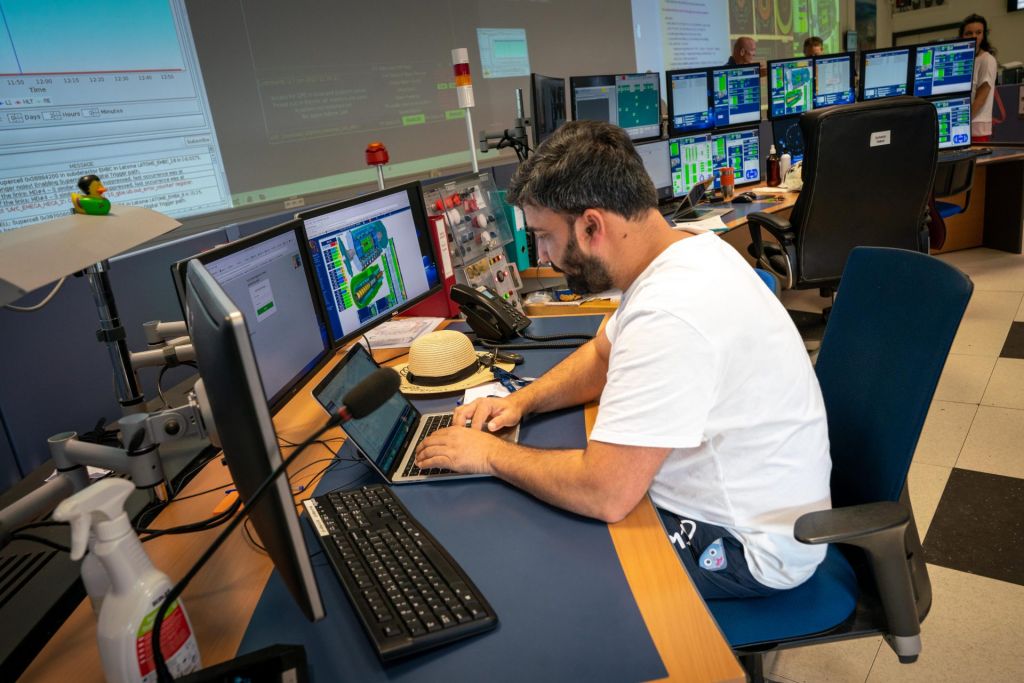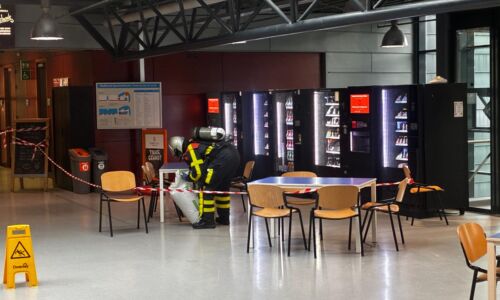Searching for the smallest building blocks of the universe
-
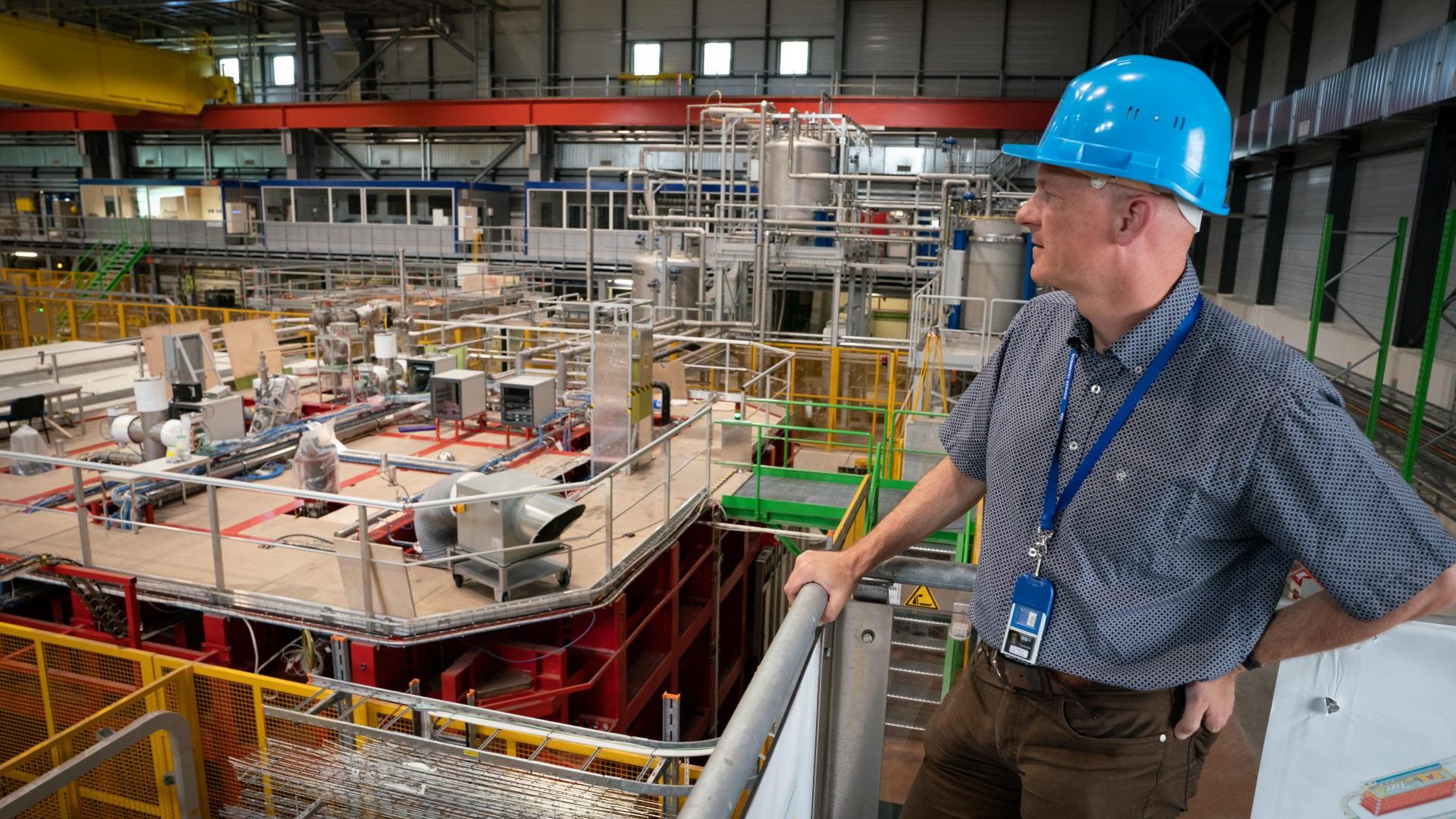 Photo: Erik van 't Hullenaar
Photo: Erik van 't Hullenaar
Deep underground, near Geneva, scientists at CERN are putting physical theories to the test. Radboud University researchers, such as particle physicist Frank Filthaut, also use these unique facilities. ‘The discovery of the Higgs particle was the highlight of my career.’
‘Find a helmet that fits you,’ says Frank Filthaut, pointing to a rack with five blue, white and red hard hats. Earlier that day, the 56-year-old physicist had already sent an email asking us to wear closed shoes. ‘When visiting the Neutrino Platform, that is preferable.’ He himself has just swapped his grey trainers for black safety boots with steel toe caps.
In his silver Citroën with a French number plate, Filthaut has just taken us to the Neutrino Platform, located in a grey building with the number 887. From the outside, it looks like an Amazon parcel distribution warehouse: a building roughly 40 by 200 metres in size, with small windows at the top.
However, once inside, the resemblance to a parcel service is remote – it is more like a construction site (hence the safety boots and helmets). Adult-sized steel structures are scattered around the floor, as are blue barrels and large concrete blocks with ‘no entry’ signs next to them. Above our heads, a movable yellow steel gantry spans the ten-metre-high hall. The activities are reminiscent of a science fiction film, where scientists conduct mysterious experiments.
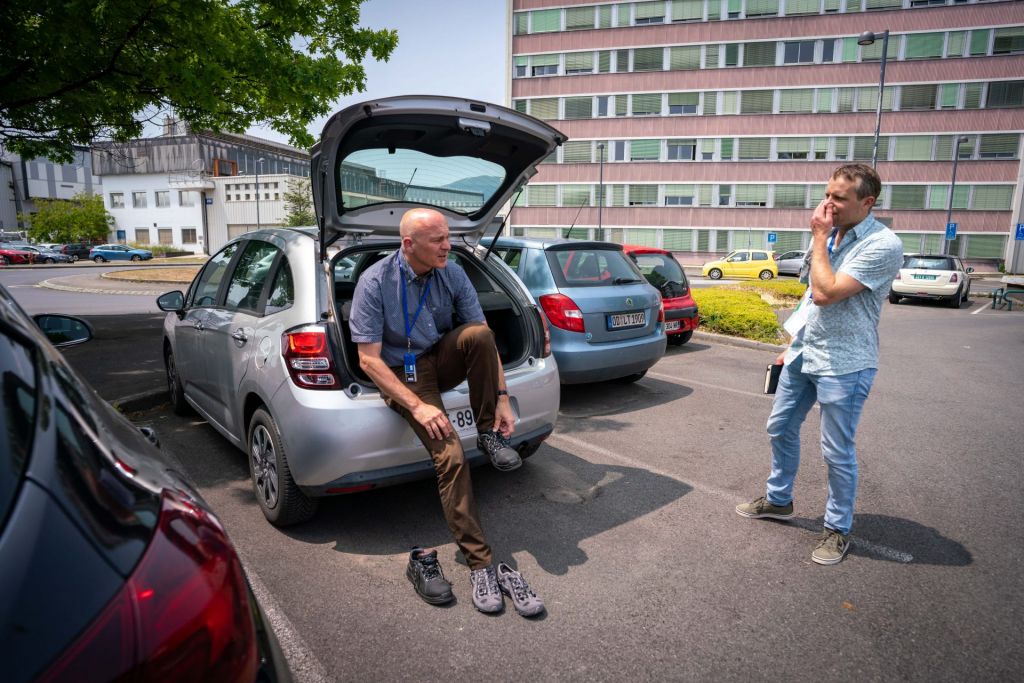
And that image is actually not so far from reality. We are at CERN, the European institution near Geneva for fundamental research on elementary particles (see box). Around 3,000 scientists from all over the world conduct research there, including physicists from Radboud University. Filthaut – tall, smiling and dressed in shirt sleeves and corduroy trousers – is one of them. At CERN, he and his colleagues are testing the Standard Model of particle physics. This physics theory describes in great detail how all kinds of different elementary particles (with exotic names like quarks, leptons and bosons) combine to form all matter around us and how they interact with each other. If the results of experiments do not match the predictions of the theory, this could change our entire understanding of the universe.
Most of the tests take place at the famous Large Hadron Collider (LHC), a 27-kilometre-long circular particle accelerator located 100 metres underground. In this ‘largest scientific experiment on Earth’, protons collide at nearly the speed of light and the scientists analyse the resulting ‘debris’.
Prototype
Radboud University has a significant stake in physics research at CERN. For instance, Filthaut, together with professor Nicolo de Groot and PhD candidate Antonio Salvucci, was involved in the discovery of the Higgs particle (‘The highlight of my career so far’). The Higgs boson gives mass to all particles in the universe. Radboud researchers have continued to work at CERN, and several PhD candidates soon defend their PhD theses in Nijmegen.
As we stand at the railing overlooking the apparatus of the Neutrino Platform, Filthaut explains how he has worked regularly at the facility near Geneva since he started his PhD research in 1990. ‘At that time, I worked with Rémy Van de Walle (professor from 1963 to 1996, ed.), one of the first researchers in the Netherlands to work on particle physics.’ Filthaut, now an associate professor, is usually based at the Huygens building in Nijmegen, but is currently working at CERN for six months. Due to a sabbatical, he is freed from teaching and management duties and can spend more time in Geneva. Whereas non-academics might prefer to take a long holiday, scientists often use a sabbatical to devote more time to research.
God particle
The Higgs particle – in technical terms: Higgs boson – is often popularly called the God Particle. Because it has such a crucial role in the Standard Model of particle physics, the Higgs boson is said to have a kind of divine status, so the story goes, all the more so because it existed for many years only on paper but was never observed – until 2012. Filthaut suggests a different – rather sobering – explanation. He laughs: ‘For years, Nobel laureate Leon Lederman (1922-2018, ed.) had searched in vain for the Higgs boson. To express his frustration, he called it the “god-damn particle”. But of course, you couldn’t use such a term as a respected scientist. So Higgs became the God Particle.’
Filthaut is also working on a project at the Neutrino Platform in building 887, which is located near the French village of Prévessin. It is called ProtoDUNE, an abbreviation for Deep Underground Neutrino Experiment. Proto indicates that this is a prototype which is to provide valuable information for designing the ‘real’, 90 times larger DUNE device that will be built in South Dakota in a few years’ time.
But even the prototype is quite impressive: it is housed in an 11-by-11-by-11-metre cube, largely sunk into the ground. Here, physicists investigate the properties of neutrinos. Like Higgs bosons and electrons, neutrinos are also elementary particles. They are also called ‘ghost particles’ because they have no charge and virtually no mass. Because they consequently interact with almost no other particles, they are essentially invisible. Of course, this makes them very difficult to detect. Filthaut: ‘Every second, billions of neutrinos pass through our bodies without us noticing.’
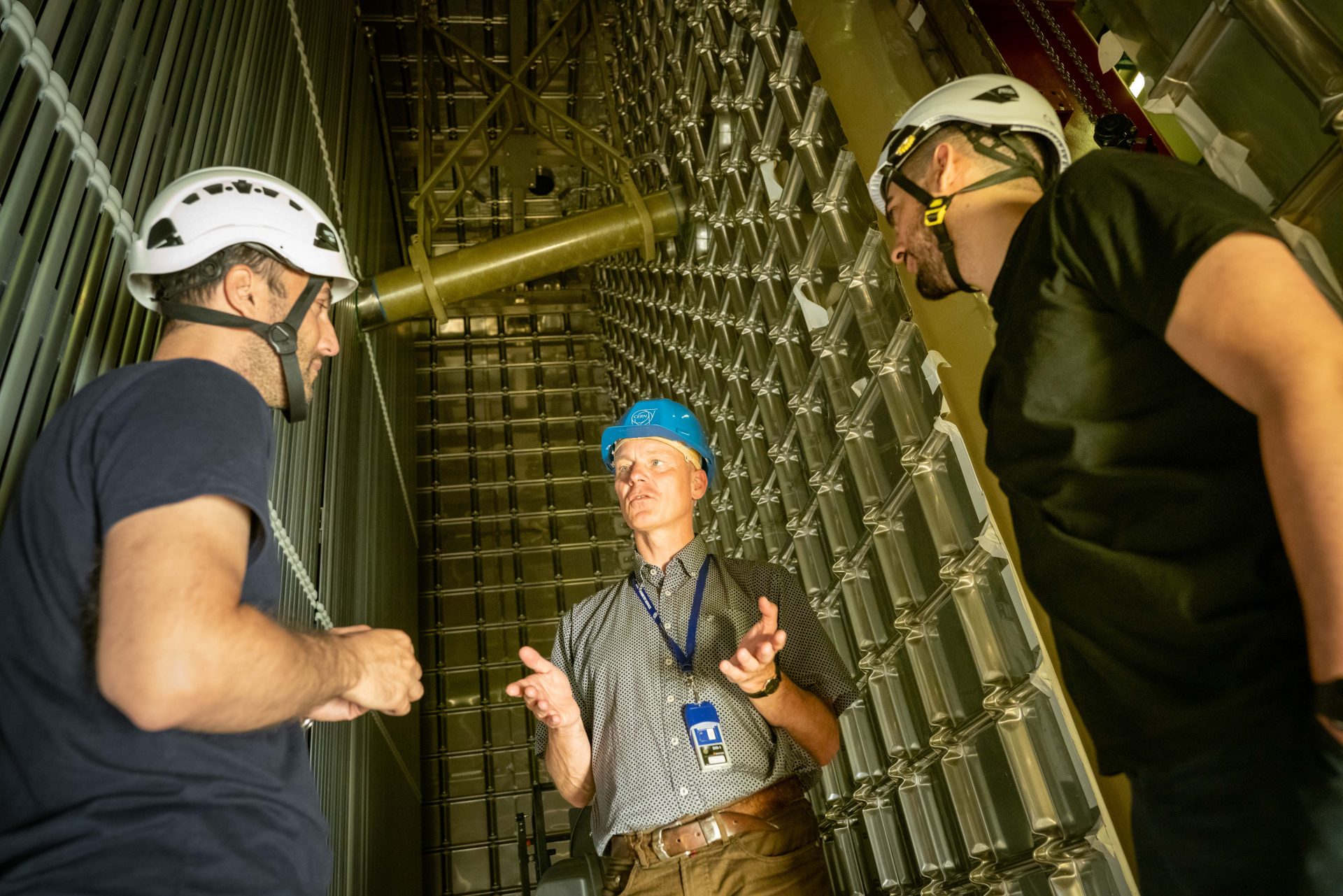
Very occasionally, however, neutrinos do collide with other particles. Then a small flash of light is produced that can be observed, and which provides information about how much energy and mass the neutrino contained. At protoDUNE, collisions take place with atoms of argon under controlled conditions. As Filthaut explains, argon is affordable, relatively heavy and chemically inert – properties that make collisions with neutrinos and other elementary particles relatively easy to identify.
Ultimately, physicists hope to answer one of the greatest mysteries in physics: why we see so few antiparticles in the universe. Antiparticles are the mirror-image version of ‘ordinary’ particles. For instance, the negatively charged electron has an antiparticle called the positron that is exactly the same, but is positively charged (they are used in PET scanners in hospitals). According to astrophysics theories, just after the Big Bang, equal amounts of matter and antimatter must have been created. ‘However,’ says Filthaut, ‘we are all made of ordinary matter, not antimatter.’
ProtoDUNE is not intended to solve the antimatter mystery. In this prototype, electrically charged particles – not neutrinos – are used to collide with the argon atoms. The experiment at CERN is mainly to test whether such a set-up with argon can work at all to detect collisions, so that the DUNE experiment in the USA (which will use actual neutrinos) can be optimally designed. ProtoDUNE will answer questions such as: How do the electronics hold up at such extremely low temperatures? And how can you design detectors to observe sporadic light flashes best?
Vacuum flask
What the protoDUNE test rig looks like in practical terms is shown by physics researchers Chris Macias and Serhan Tufanli – thirty-somethings both wearing white helmets and shorts – as we descend to one of the two red-painted cubes in hall 887. This, they tell us, is a cryostat – essentially a huge vacuum flask. Filthaut: ‘This normally contains liquid argon at a temperature of minus 186 degrees C.’ That temperature has to be very precise. A few degrees colder, and the liquid solidifies. When it gets a little warmer, argon turns into gas. A metre-thick insulation layer ensures that not too much energy is required to maintain the temperature. The inner chamber can hold 565 cubic metres of argon; the filling process takes several weeks.
Now, however, the cube is empty and we can take a look inside. ‘The experiment is on hold,’ Filthaut explains, ‘because argon is currently too expensive due to the war in Ukraine. Hopefully, in six months’ time, we can continue.’ Even elementary particle research suffers from geopolitics.
All six inner walls are lined with aluminium-coloured metal plates with a waffle pattern. Filthaut points to a sewer-pipe-sized tube sticking diagonally into the room above him. ‘That tube carries the charged particles that collide with the argon.’ Those particles are created, Macias adds, when protons originating from a particle accelerator (located half a kilometre away) collide with a chunk of beryllium.
‘How do you get data from the detector to a data storage location?’
Lamella grids full of electronics positioned a metre or so away from the wall then capture the metre-long light trace created when the charged particles collide with argon atoms. Using clever detection technology, these electronics reconstruct a three-dimensional image of the light trace, a kind of 3D photo.
‘The role of the Nijmegen researchers in this project is mainly in extracting and analysing all this data,’ Filthaut explains. ‘How do you get data from the detector to a data storage location?’ This may sound like a trivial problem, but standard data cables have far too little capacity to handle such large amounts of data at high transmission rates.
Filthaut and his colleagues devised sophisticated solutions for this, which are now built into protoDUNE. ‘It is basically the same approach that is used in the FELIX system, which we also co-designed.’ FELIX is the data-processing component of ATLAS, one of the collision detectors of the LHC particle accelerator (not to be confused with the Nijmegen laser lab HMFL-FELIX).
Passport control
This ATLAS detector is the second project at CERN that Filthaut and other Nijmegen scientists are working on. The access building for ATLAS is a seven-minute drive from the Neutrino Platform. We left the hardhats behind. But now we have to cross the border, from France to Switzerland.
For employees here, this is routine. Filthaut: ‘CERN is a sprawling complex and actually has several campuses, which is why I usually travel by bike. Because Switzerland is also part of Schengen, you can just pass through the border without a passport check.’ In contrast, every time we enter a site of one of the CERN buildings, everyone is checked. Filthaut has to show his employee badge, and media representatives show their visitor passes and a passport.
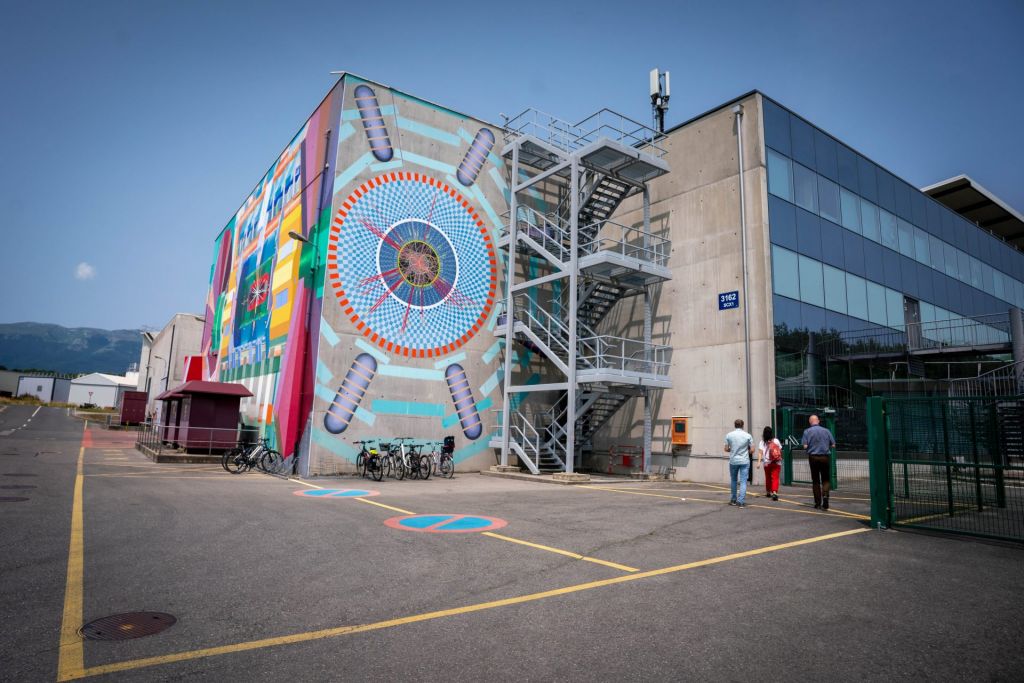
The building with the ATLAS control room cannot be missed. A large mural of blue circles surrounded by purple ‘detectors’ adorns one of the exterior walls. At the centre of the mural, dozens of red lines are intended to represent the subatomic fragments that are ejected after a proton collision. It is one of the few CERN buildings with any ornamentation. Most are anonymous offices in 1980s style with low-hanging system ceilings, wooden doors and dark vinyl floor covering. The absence of stylish décor emphasises that the multimillion-dollar grants are mainly spent on particle research, not on modern architecture. The buildings here do not have names, as at Radboud University, but are simply numbered in the order in which they were built.
CERN
The Conseil Européen pour la Recherche Nucléaire (CERN) was founded in 1954 by 12 European countries to conduct joint research on subatomic particles, the fundamental building blocks of the universe. At present, 22 European countries, plus Israel, are participating. The complex, located on the border between Switzerland and France, has multiple research facilities, including several circular particle accelerators (with LHC being the largest) and linear (straight) accelerators.
CERN is not one site, but consists of several campuses spread across the rural border area of Switzerland and France, near Geneva.
Several CERN researchers have been awarded Nobel prizes, including Simon van der Meer from the Netherlands (1984, for the discovery of W and Z bosons), Georges Charpak (1994, for the development of a particle detector) and Higgs theorists François Englert and Peter Higgs (2013).
CERN has an annual budget of over €1 billion, of which the Dutch government contributes about €50 million. The current director of CERN, Fabiola Gianotti, will be awarded an honorary doctorate from Radboud University in October.
Because the LHC was in full operation, it was not possible to take a closer look at the detector or the LHC accelerator tube itself. With protons racing through them at nearly the speed of light in a vacuum, the conditions are simply too hazardous. At maintenance times, you can descend into the tube from various points on top of the circular particle accelerator, which is located 100 metres underground.
All proton collisions are monitored remotely, from the ATLAS control room. With dozens of computers and large screens on the wall, it is reminiscent of a missile launch control room, with a handful of people working intensely.
23.376.185.243.968.853. As shown by a counter in the hall, this is how many individual collisions ATLAS has observed since it began operating in 2003. Information screens on the wall explain how the detector operates, and next to the entrance, a LEGO scale model is shown in a display case. ‘About 1.25 billion collisions take place every second,’ Filthaut says. ‘That creates a chaos of fragments from which the interesting debris must be fished out. That is the biggest challenge for us.’
In a few years, the number of collisions will be as much as 5 billion per second. To deal with this, ATLAS is getting a more advanced ’tracking detector’ in a few years’ time. ‘I mainly participate in discussions on how to get the specifications right for this new detector.’ The tracking detector is essentially a high-speed camera that records the paths taken by the particles ejected in the nanoseconds after a collision. ‘The current tracking detector is being completely replaced because it is becoming increasingly ineffective. The semiconductor sensors have all suffered radiation damage in recent years, which is inherent to this type of experimentation.’ It is somewhat comparable to a camera that has more and more dead pixels.
World Wide Web
So isn’t particle accelerator research finished now that the Higgs particle has been discovered? No, says the physicist firmly. ‘We still don’t understand a lot of things about the Higgs boson. To name just one: it is much lighter than we expected based on the prevailing theories.’ Because there will soon be four times as many collisions, research into this aspect will become easier. ‘The theory predicts a specific statistical distribution of particles that are created when a Higgs boson decays,’ Filthaut explains. The more particles you can observe, the better you can test that predicted distribution.
Meanwhile, the researchers at CERN are looking even further ahead, towards an entirely new accelerator: the Future Circular Collider (FCC). The FCC is envisioned to be 90 kilometres long, thus allowing protons to collide with each other with seven times more energy and creating even more particle debris. ‘That way we can study everything with even greater precision.’ Filthaut laughs as he notes that he will have retired before then, assuming that the FCC is built at all; it currently exists only on the drawing board.
‘It is fantastic to be able to engage with something that describes the world to a very deep level’
Still, those hundreds of millions of Euros for basic research, aren’t they needed more urgently in other sectors, such as healthcare? ‘Robert Wilson, the founder of the Fermilab in the USA had a good answer to such questions in the 1970s,’ says Filthaut. ‘When he was asked whether the money would be better spent on, say, defence, he replied: ‘This type of research makes our country worth defending.’‘ Moreover, continues Filthaut, CERN research has already contributed to all kinds of societal applications, such as the World Wide Web – which was developed at CERN to simplify data exchange between computers – and the touchscreen. ‘And don’t forget proton therapy for cancer treatment. The accelerators needed for this are based in part on what has been developed here in Geneva.’
Filthaut himself is mainly motivated by the desire to understand nature as much as possible, he tells us when we are getting ready to leave. ‘That is a deep human need, I think.’ As far as he is concerned, little can match the euphoria he felt after the discovery of the Higgs boson. ‘It is fantastic to be able to engage with something that on the one hand seems very abstract, but on the other hand describes the world to a very deep level, whether you are here or billions of light years away. I still find it amazing that a measurement of, for example, the electron magnetic dipole moment matches exactly what you predict mathematically – to twelve or more decimal places.’
